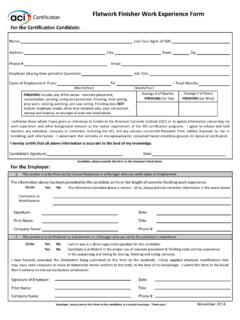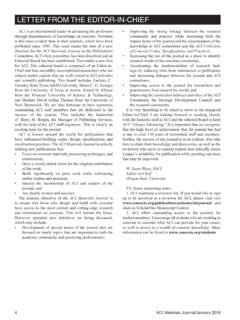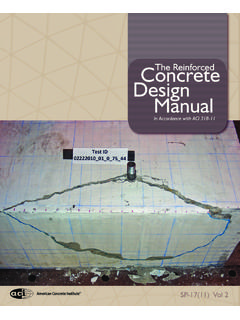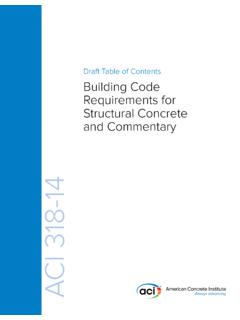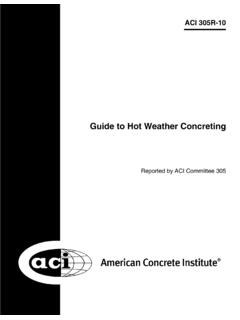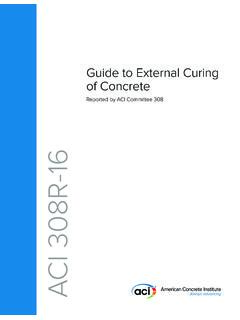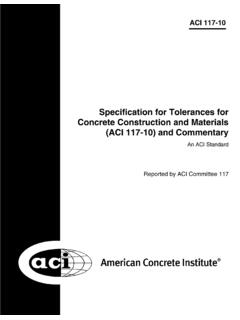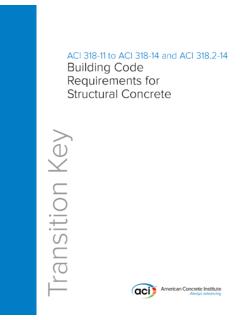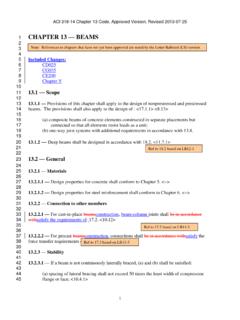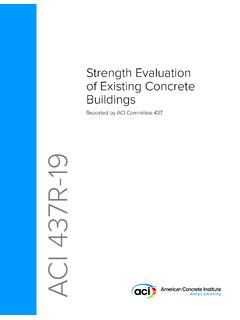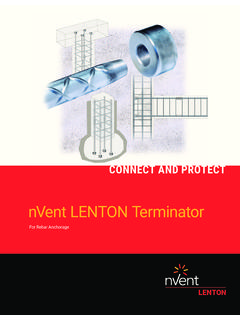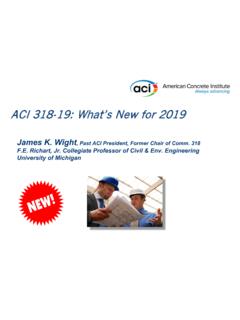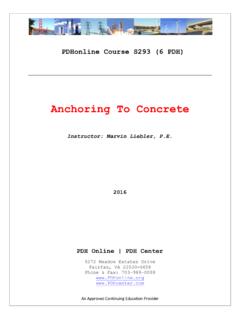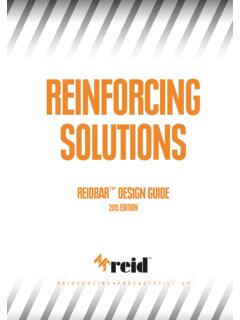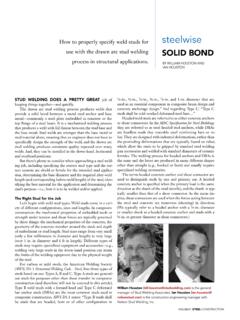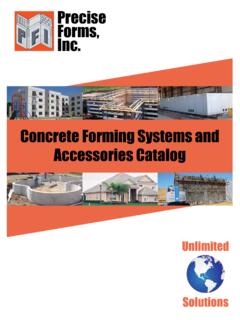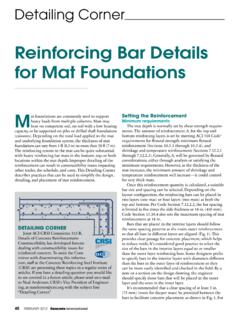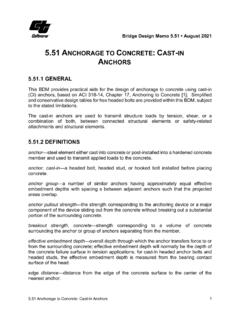Transcription of (Reapproved 2006) REINFORCEMENT FOR CONCRETE— …
1 E2-1 ACI Education Bulletin 2000, American Concrete rights reserved including rights of reproduction and use in any form or by anymeans, including the making of copies by any photo process, or by electronic or mechan-ical device, printed, written, or oral, or recording for sound or visual reproduction or foruse in any knowledge or retrieval system or device, unless permission in writing isobtained from the copyright proprietors. Printed in the United States of Institute is not responsible for the statements oropinions expressed in its publications. Institute publicationsare not able to nor intended to supplant individual training,responsibility, or judgment of the user, or the supplier of theinformation , p. E2-2 Chapter 1 Introduction, p. DefinitionsChapter 2 Structural concrete: Plain, reinforced, and prestressed, p. Plain Reinforced Bending and bending stresses in reinforced Other REINFORCEMENT Prestressed Bending and bending stresses in prestressed Advantages of prestressed Pretensioned and post-tensioned Other prestressing applicationsChapter 3 Reinforcing materials, p.
2 Steel Deformed steel Threaded steel Welded wire Fiber-reinforced polymer (FRP) FRP Fiber Steel Synthetic Materials for repair and strengthening of structuralconcrete External steel FRP plates, sheets, and jacketsChapter 4 Prestressing materials, p. Seven-wire Applied loadsChapter 5 Corrosion-resistant REINFORCEMENT ,p. Epoxy Stainless Chemical and mineral corrosion protection systems REINFORCEMENT FOR CONCRETE MATERIALS AND APPLICATIONSACI Education Bulletin E2-00 (Reapproved 2006) Developed by Committee E-701,Materials for Concrete ConstructionCharles K. Nmai, Chairman David M. Suchorski, SecretaryLeonard W. BellTarek S. KhanKenneth B. RearRichard P. Bohan Paul D. KraussRaymundo Rivera-VillarrealDavid A. BurgColin L. LoboJere H. RoseDarrell F. ElliotStella Lucie MarusinPaul J. TikalskyJames ErnzenPatrick L. McDowellMark E. VincentJames A. FarnyGerald R.
3 MurphyChristopher H. WrightJose Pablo GarciaAnthony C. Powers*Kari L. YuersMorris HuffmanRobert C. Zellers*Subcommittee EDUCATION BULLETINC hapter 6 Storage and handling, p. Uncoated steel Epoxy-coated steel Fiber reinforcementChapter 7 References, p. E2-15 PREFACEThis document is an introductory document on the topic ofcommonly used materials for REINFORCEMENT of concrete. Thisprimer describes the basic properties and uses of these is targeted at those in the concrete industry not involved indesigning with or specifying these materials. Students,craftsman, inspectors, and contractors may find this a valuableintroduction to a complex topic. The document is not intendedto be a state-of-the-art report, user's guide, or a technicaldiscussion of past and present research findings on the detailed information is available in ACI CommitteeReports listed in Chapter 7, 1 INTRODUCTIONN early everyone involved in construction knows that rein-forcement is often used in concrete.
4 However, why it is usedand how it is used are not always well bulletin provides some of the information important tounderstanding why REINFORCEMENT is placed in concrete. Mostconcrete used for construction is a combination of concreteand REINFORCEMENT that is called reinforced concrete. Steel isthe most common material used as REINFORCEMENT , but othermaterials such as fiber-reinforced polymer (FRP) are alsoused. The REINFORCEMENT must be of the right kind, of the rightamount, and in the right place in order for the concrete struc-ture to meet its requirements for strength and this document, frequent references are made to standardsof the American Society for Testing and Materials (ASTM).These include test methods, definitions, classifications, andspecifications that have been formally adopted by editions of the ASTM Book of Standards are issuedannually and all references to these standards in this bulletinrefer to the most recent edition.
5 Other agencies have similar oradditional standards that may be DefinitionsCertain terms will be used throughout this bulletin withwhich familiarity is important. A few of the more commonand most frequently used are listed in this section. Precisetechnical definitions may be found in ACI 116R, Cement andConcrete Terminology. bar size number a number used to designate the bar bars are manufactured in both InternationalSystem (SI commonly known as metric measured in milli-meters), and customary ( ) sizes. The bar number formetric bar sizes denotes the approximate diameter of the barin millimeters. For example, a No. 13 bar is about 13 mm indiameter (actually mm). customary bar sizes No. 3through No. 8 have similar designations, the bar numberdenoting the approximate diameter in eighths of an inch (forexample, a No. 5 bar is about 5/8 in. in diameter).
6 Bent bar a reinforcing bar bent to a prescribed shape,such as a straight bar with a hooked a state in which an object is subject to loadsthat tend to crush or shorten bar a reinforcing bar used to resistcompression strength a measure of the ability of theconcrete to withstand crushing limit the limit to which a material can be stressed(stretched or shortened axially) and still return to its originallength when unloaded. Loads below the elastic limit result inthe material being deformed in proportion to the load. Materialstretched beyond the elastic limit will continue to deformunder a constant, or even declining, fibers synthetic fibers used to reinforceconcrete that are bundled in a mesh resembling a miniaturefish REINFORCEMENT reinforcing bars, wires or strandmade from fiber-reinforced polymer (FRP). (Originally, the p in FRP stood for plastic, but polymer is now thepreferred term to avoid confusion.)
7 Monofilament fibers discrete individual fibers used toreinforce a method of prestressing in which thetendons are tensioned after the concrete is concrete Structural concrete in whichinternal stresses (usually compressive stresses) have beenintroduced to reduce potential tensile stresses in the concreteresulting from loads. This introduction of internal stresses isreferred to as prestressing and is usually accomplishedthrough the use of tendons that are tensioned or pulled tightprior to being anchored to the a method of prestressing in which thetendons are tensioned before concrete is an abbreviated term for reinforcing concrete structural concrete with at least acode-prescribed minimum amount of prestressed or nonpre-stressed REINFORCEMENT . Fiber-reinforced concrete is notconsidered reinforced concrete according to this REINFORCEMENT nonstructural reinforcementsuch as welded wire fabric, fibers, or bars to minimize crackwidths that are caused by thermal expansion and contraction,or shrinkage.
8 Secondary REINFORCEMENT is REINFORCEMENT usedto hold the concrete together after it cracks. Structuralconcrete with only secondary REINFORCEMENT is not consideredreinforced fibers carbon or stainless steel fibers used in fiber-reinforced concrete meeting the requirements of ASTM A concrete all concrete used for structuralpurposes including plain and reinforced a wire, cable, bar, rod, or strand, or a bundle ofsuch elements, used to impart prestress to concrete. Tendonsare usually made from high-strength steel, but can also bemade from such materials as strength a measure of the ability of a material (forexample, concrete or REINFORCEMENT ) to withstand FOR CONCRETEE2-3 Tension in both the concrete and REINFORCEMENT results whenreinforced concrete bends under a state in which a material is subject to loads thattend to stretch or lengthen strength The stress required to stretch a material toits elastic 2 STRUCTURAL CONCRETE.
9 PLAIN, REINFORCED, AND PRESTRESSEDThe design and construction of structural concrete, bothplain and reinforced (including nonprestressed andprestressed concrete) is covered by ACI 318, Building CodeRequirements for Structural Concrete, and ACI 301, Stan-dards Specification for Structural Plain concretePlain concrete is structural concrete without reinforcementor with less than the minimum amount required by ACI 318for reinforced concrete. It is sometimes used in slabs-on-grade, pavement, basement walls, small foundations, Reinforced concretePlain concrete (Fig. ) has compressive strength theability to resist crushing loads; however, its tensile strength isonly about 10% of its compressive strength. Its tensile strengthis so low that it is nearly disregarded in design of most concretestructures. Reinforced concrete is a combination of adequatereinforcement (usually steel bars with raised lugs called defor-mations) and concrete designed to work together to resistapplied loads (Fig.)
10 Properly placed REINFORCEMENT inconcrete improves its compressive and tensile Bending and bending stresses in reinforced concretemembers Many structural members are required to carryloads that cause bending stresses. An example is a simply-supported beam, in which the top of the member is subjectedto compression lengthwise while the bottom is subjected totension lengthwise (Fig. (a)). This is referred to as beamaction and can be illustrated by supporting a board at each endand breaking it by applying a heavy load to the center. If theboard is loaded at each end and supported in the middle, as ina cantilevered beam, the top of the board over the support is intension and the bottom is in compression (Fig. (b)).Unreinforced concrete structural members have littlecapacity for beam action because concrete s low tensilestrength provides little resistance to the tensile stress in thetension side of the member.
